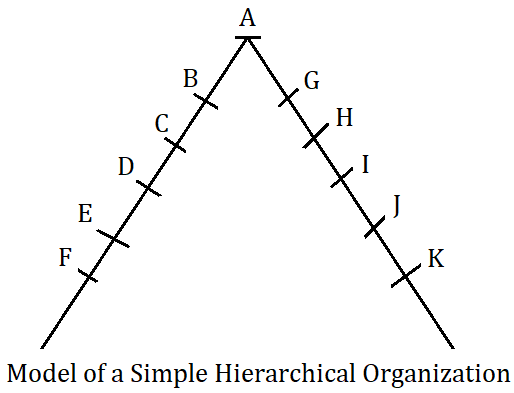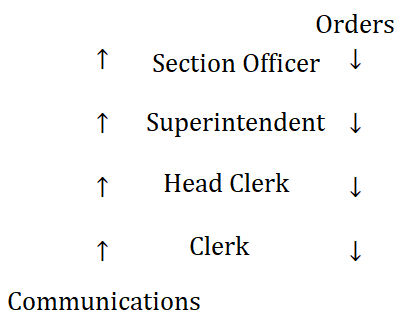Table of Contents
Principle of Hierarchy:
The Principle of Hierarchy, which is also known as the Scalar Process, stands recognized as a fundamental principle of organization. Mooney and Relley describe it as “the eternal and universal principle of organization.” Hierarchy means the rule or control of the higher over the lower. It can also be described as a ‘pyramidal’ or hierarchical set of parts in which the higher parts control the lower parts. A hierarchical organization begins with one person at the top, breaks into many sections, and finally descends into the workers who are at its base. It is a concept for the arrangement of various units of organization which have to be grouped at several levels in the form of a pyramid- broad at the base, tapering upward and resulting into a single vertex.
In a hierarchical organization, authority exclusively belongs to the chief executive at the top. He delegates it to the different parts immediately below him, who in turn delegate it to their immediate subordinates. This process of delegation goes on till the bottom line is reached. Each official to whom authority is delegated becomes responsible for doing the job. Thus authority flows from top to bottom and responsibility extends from the bottom upwards.
Hierarchy Definition:
Defining Hierarchy, Marx writes, “Hierarchy means the grouping of units into a large unit for the direction and control of activities. It is the method whereby the efforts of many different individuals are geared scale-wise.”
Earl Latham defines Hierarchy as an “ordered structure of inferior and superior beings in an ascending scale. The good chief dwells at the apex from which, with his terrible eye, can search out the hearts of his lowest subordinates and mold their deeds to his command.”
J. D. Millet defines Hierarchy as “a method whereby the efforts of different individuals are geared together.”
In the words of Prof. L. D. White, “Hierarchy consists in the universal application of the superior-subordinate relationship through a number of levels of responsibility reaching from the top to the bottom of the structure.” It means a graded organization of several successive steps in which each of the lower levels is immediately subordinate to the next higher one and through it to the other higher steps till we reach the apex. The immediate lower is responsible for the next higher one and through it to the other higher steps right up to the top. When authority descends from the top to downwards step by step, it is a hierarchical organization.”
James Mooney and his colleagues conceptualize hierarchy as the Scalar Process and give to it a systematic meaning. Mooney and Reiley observe, “A scale means a series of steps, something graded. In an organization, it means the grading of duties, not according to different functions but according to the degree of authority and corresponding responsibility. For convenience, we shall call this phenomenon of organization the scalar chain….whenever we find an organization even of two people, related as superior and subordinate, we have the scalar principle. This chain constitutes the universal process of coordination through which the supreme coordinating authority becomes effective throughout the entire structure.”
Thus, Hierarchy means the grouping of units into a large unit for the direction and control of activities. It is the method whereby the efforts of various individuals are geared together to achieve a goal through a system of interlocking superior-subordinate relations from the top to the bottom.
Features of Hierarchy:
Following are some of the important features of Hierarchy:
- All administrative functions are vested into units and sub-units.
- These units are organized in the form of a pyramid one below the other.
- Authority is distributed to various levels.
- A hierarchical organization observes the principle of ‘through proper channel’.
- All commands and communications should come through the proper channel. No intermediate level can be ignored.
- A person receives orders only from one superior officer and not from anybody else. This means the principle of unity of command is observed.
- Authority and responsibility are adequately combined. Authority without responsibility is dangerous, while responsibility without authority is meaningless.
The principle of hierarchy can be illustrated with the help of the following scale or diagram:

In the diagram, A is at the apex of the organizational pyramid. He is the head of the organization. B is A’s subordinate, C is the immediate subordinate of B, and also a subordinate of A through B. Thus if we go down the line, F is the immediate subordinate of E and also a subordinate of A. Thus orders flow from top to bottom, namely from A to B, B to C, C to D, D to E, and E to F, and communications from bottom to top namely from F to E, E to D, and so on. The same is true of the other side of the triangle A to K. If A wants to issue an order to F, it has to travel through B, C, D, E and if F has to communicate something to K, it has to travel through E, D, C, and B to A and descend from A to K step by step; F, A, K in this diagram represent the line of authority linking the entire organization. The travelling of orders from A to F step by step in a descending order and the flow of communication from F to A in an ascending order is called communication ‘through proper channel’.
This principle can also be explained through the following example:

If the Section Officer wants to issue an order to the clerk, it has to go through the Superintendent and the Head Clerk. Similarly, a proposal from the Clerk to the Section Officer travels through the Head Clerk and the Superintendent to reach the Section officer.









Comments (No)